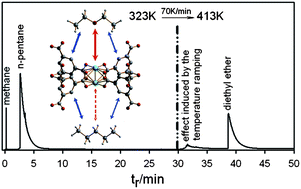HKUST-1 as an open metal site gas chromatographic stationary phase—capillary preparation, separation of small hydrocarbons and electron donating compounds, determination of thermodynamic data†
Abstract
The development of cyclic preparation techniques based on the application of an SBU (secondary building unit) precursor and a linker solution for the generation of MOF (metal–organic framework) coatings were used to prepare HKUST-1 (Hong Kong University of Science and Technology-1) coated capillary gas-chromatographic columns. As a prerequisite for the conducted preparation of the coatings some optimisation of the procedure for the generation of the MOF material at room temperature was carried out. Beside the demonstration of their general suitability for the separation of permanent gases, the capillaries were used to perform isothermal retention time measurements with analytes possessing electron donating capabilities, such as aromatic or oxygen containing compounds. Since HKUST-1 possesses SBUs with open metal sites, the heat of

- This article is part of the themed collection: Integrating functionality into metal–organic frameworks

 Please wait while we load your content...
Please wait while we load your content...